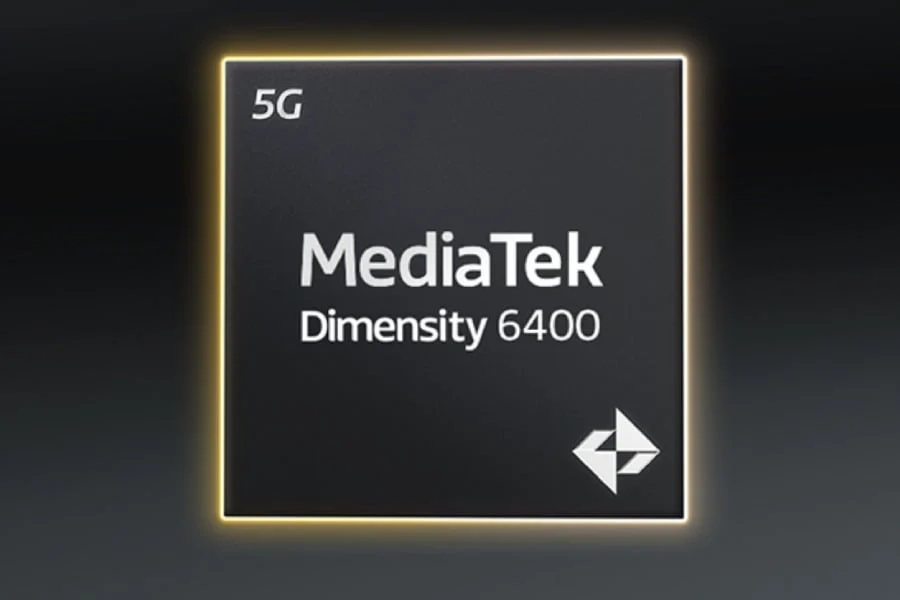Key Takeaways
1. The Dimensity 6400 is a minor update to the Dimensity 6300, featuring an overclocked prime core but lacking significant new features.
2. It uses the same 6nm manufacturing process and octa-core configuration, with two Cortex-A76 cores and six Cortex-A55 cores.
3. The chipset supports cameras up to 108MP and has memory support for LPDDR4x RAM and UFS 2.2 storage, which are standard for mid-range devices.
4. Connectivity options include 5G support (SA and NSA), Wi-Fi 5, Bluetooth 5.2, and compatibility with various global navigation systems, but it lacks Wi-Fi 6.
5. The Realme P3x 5G will be the first smartphone to use the Dimensity 6400, launching on February 18th in India.
MediaTek has unveiled its latest System on Chip (SoC), the Dimensity 6400. However, there’s not much that’s new about it. This new chip is merely a small update to last year’s Dimensity 6300, featuring an overclocked prime core but not much else that distinguishes it.
Specifications Overview
The Dimensity 6400 continues to utilize TSMC’s 6nm manufacturing process and maintains the same octa-core configuration as its predecessor. It even retains the same GPU. It’s also worth noting that the Dimensity 6100+ from 2023 already had similar core specifications. Thus, at best, we can see this as a rebranded version of the 2023 chipset with just a minor increase in clock speed.
CPU and Performance Details
This new chip comes with an octa-core structure that includes two Cortex-A76 cores that can reach frequencies of up to 2.5GHz, alongside six Cortex-A55 cores running at 2.0GHz. The only change from the Dimensity 6300 is the slight increase in the frequency of the prime core from 2.4GHz to 2.5GHz, which probably won’t significantly enhance CPU performance. Like many modern SoCs, it supports heterogeneous multi-processing to better manage workloads across its cores.
For graphics, MediaTek has chosen the Arm Mali-G57 MC2 GPU, which is again the same as the previous model. While this GPU isn’t top-tier, it should handle casual gaming and video watching adequately. The chipset can support displays with a maximum resolution of 2520 x 1080 and a refresh rate of 120Hz.
Camera and Memory Features
The Dimensity 6400 is equipped with an Image Signal Processor (ISP) that can handle cameras up to 108MP. For dual-camera configurations, it can support setups of 16MP + 16MP, which is typical for mid-range SoCs. Support for 3D LUT color management is included, but MediaTek has not revealed any notable advancements in computational photography.
This chip also supports LPDDR4x RAM up to a speed of 2133MHz and UFS 2.2 storage. Although these aren’t the most advanced memory and storage options on the market, they should be sufficient for mid-range devices.
Connectivity Options
As anticipated, the Dimensity 6400 supports both SA and NSA 5G, with dual SIM capabilities. It boasts a peak download speed of 3.3Gbps, which is comparable to other mid-range 5G chips. The inclusion of 5G carrier aggregation (CA) and dual Voice over NR (VoNR) ensures that connectivity remains stable, even in areas with poor signal strength.
The chip features Wi-Fi 5 (802.11ac) with a 1T1R antenna configuration, Bluetooth 5.2, and compatibility with multiple global navigation satellite systems like GPS, BeiDou, Glonass, Galileo, QZSS, and India’s NavIC. Nonetheless, the absence of Wi-Fi 6 could be a downside for those seeking more robust and future-ready connectivity options.
The Realme P3x 5G has been confirmed as the first smartphone to be powered by the Dimensity 6400, with its launch scheduled for February 18th in India.


Leave a Reply